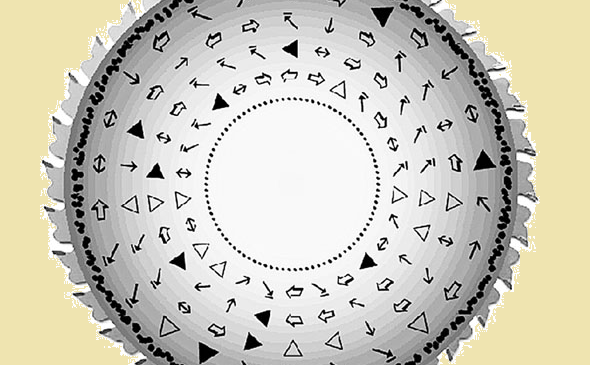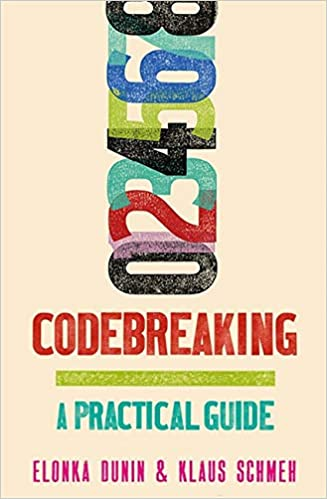A challenge cryptogram from a 2012 puzzle book is still unsolved. The author will award a book copy to the first one to break it.
Earlier this year, I was contacted by Frank Schwellinger, the author of the 2012 book Warum gibt es kein Bier auf Hawaii? (“Why is there no beer on Hawaii?”). The title is an allusion to a famous German drinking song.
The Ivory Coast cryptogram
Frank Schwellinger’s book presents a collection of 50 puzzles, each one being connected to a certain country. Puzzle #2 is based on a background story situated in the African country, Ivory Coast. The challenge is about the following image:
The solution of this challenge is not provided in the book nor, according to Frank Schwellinger, has a reader ever found it. In July this year, I introduced this cryptogram in a blog post. There were many interesting comments, but in the end, my readers couldn’t decipher this message, either.
♦♦♦♦♦♦♦♦♦ Coming December 2020 ♦♦♦♦♦♦♦♦♦♦♦♦♦
“One of the most helpful guides outside the NSA to cracking ciphers. But even if you don’t become a codebreaker, this book is full of fascinating crypto lore.”
Steven Levy, New York Times bestselling author of “Crypto, Hackers, and Facebook: The Inside Story”
♦♦♦♦♦♦♦♦♦♦♦♦♦♦♦♦♦♦♦♦♦♦♦♦♦♦♦♦♦♦♦♦♦♦♦♦♦♦
A summary and new hints
Frank Schwellinger has now provided me a summary of the discussion about the Ivory Coast cryptogram, as well as two new hints. Here’s what he sent me (he wrote in German, I added an English translation):
1) Der Klartext besteht aus einem Satz.
1) The plaintext consists of one sentence.
2) Dieser Satz bezeichnet ein Lösungswort und zwar völlig eindeutig. Dieses Wort wird gesucht.
2) This sentence designates a solution word completely unambiguously. This word is searched for.
3) Narga liegt mit seinem Kommentar #6 vollkommen richtig. Der Klartext wurde zuerst einfach im Windings3 Font dargestellt. Dass Narga damit auf eine typisch deutsche Buchstabenhäufigkeit stößt, ist daher verständlich und auch so beabsichtigt, damit unter den unzählig vielen Ansatzmöglichkeiten darauf geschlossen werden kann, dass man sich auf der richtigen Spur befindet. Der gewählte Font war zwar ungewöhnlich aber wurde mit alten MS Office-Versionen standardmäßig ausgeliefert, so dass es genug Menschen geben muss, die ihn schon einmal gesehen haben. Den Font kann man sich übrigens auch kostenlos von diversen Seiten mit freien Fonts herunterladen. Narga liegt auch richtig damit, dass das Leerzeichen durch das “-“-Zeichen ersetzt wurde. Seine Vermutung, dass eine Transposition folgt, ist ebenfalls korrekt. Ich habe jedoch nicht geprüft, ob seine Transkription korrekt ist. Da der Font bekannt ist, kann das jeder selbst prüfen.
3) Narga is absolutely right with his comment #6. The plaintext was first simply displayed in the Windings3 font. It is therefore understandable that Narga encounters a typical German letter frequency, and this is also the intention, so that among the countless possible approaches it can be concluded that one is on the right track. The chosen font was unusual but was delivered with old MS Office versions by default, so there must be enough people who have seen it before. You can download the font for free from various sites with free fonts. Narga is also correct in that the space character has been replaced by the “-” character. His assumption that a transposition follows is also correct. But I did not check if his transcription is correct. Since the font is known, everyone can check that for himself.
4) Das Kryptogramm ist schwierig aber lösbar. Das ist ein wichtiger Hinweis, den viele Leser außer acht lassen. Es würde keinen Sinn machen, in einem Rätselbuch ein unlösbares Rätsel abzudrucken. Es hat sich ein Leser darüber beklagt, dass es so viele Möglichkeiten gäbe und es sich auch um eine Maskierung handeln könne aber wenn ich bereits die zu meiner Sprache passende Buchstabenhäufigkeit habe, ist Transposition wahrscheinlicher als Maskierung und meine Möglichkeiten, die Verschlüsselung zu verkomplizieren sind begrenzt, wenn der Algorithmus unbekannt ist und die Chiffre lösbar sein soll. Sobald der Ansatz zu kompliziert ist, ist er falsch, solange er zu einfach ist, ist er ebenfalls falsch. Bei der Transposition kann es sich ebenfalls nicht um irgendeine beliebige Permutation der Zeichen handeln, weil dies viel zu schwierig und wahrscheinlich sogar unlösbar wäre. Folglich muss diese Transposition einem bestimmten System folgen. Manchmal hilft der gesunde Menschenverstand unter unzähligen Möglichkeiten, die richtige zu finden.
4) The cryptogram is difficult but solvable. This is an important clue that many readers disregard. It would not make sense to print an unsolvable puzzle in a puzzle book. One reader complained about the fact that there are so many possibilities and it could be a masking but if I already have the frequency of letters matching my language transposition is more likely than masking and my possibilities to complicate the encryption are limited if the algorithm is unknown and the cipher should be solvable. As soon as the approach is too complicated it is wrong, as long as it is too simple it is wrong as well. The transposition cannot be any arbitrary permutation of the characters either, because this would be much too difficult and probably even unsolvable. Thus this transposition must follow a certain system. Sometimes common sense helps to find the right one among countless possibilities.
5) Dies ist ein neuer Tipp, der sich auf Tipp 4 stützt: Natürlich könnten die Pfeile eine geometrische Bedeutung besitzen, die für die Transposition eine Rolle spielt. Dem ist aber nicht so. Die Geometrie der Pfeile besitzt keinerlei Bedeutung. Sie dienen nur der Verwirrung.
5) This is a new tip based on tip 4: Of course, the arrows could have a geometrical meaning that plays a role in the transposition. But this is not the case. The geometry of the arrows has no meaning. They only serve to confuse.
6) Ich habe die Leser auch immer wieder dazu aufgefordert “herauszufinden”, was dieses Rad denn darstellen soll, weil Kontextinformationen zu besitzen, nie verkehrt sein kann. Ich war sehr überrascht, wie lange es dauerte, bis ein Leser auf die Idee kam, bei Amazon mit einem “Blick ins Buch” nachzulesen, dass es sich um “das geheimnisvolle silberne Sonnenrad” handelt. Damit kann man versuchen nach einem “guessed plaintext” zu suchen, was dann ein Leser auch zumindest versucht hat.
6) I also asked the readers again and again to “find out”, what this wheel should represent, because having context information can never be wrong. I was very surprised how long it took a reader to come up with the idea to “look into the book” at Amazon to find out that it is “the mysterious silver sun wheel”. So you can try to search for a “guessed plaintext”, which a reader at least tried to do.
7) Dies ist ein zweiter neuer Tipp, der sich jetzt auf Tipp 6 bezieht: Der Teilstring “sonnen” kommt mindestens einmal im Klartext vor.
7) This is a second new tip, which now refers to tip 6: The substring “sonnen” occurs at least once in plain text.
Can a reader solve the Ivory Coast cryptogram with this summary and these new hints? If so, please leave a comment. Frank Schwellinger has promised to award a copy of his book to the first successful codebreaker. Good luck!
Follow @KlausSchmeh
Further reading: Ron Rivest publishes new time-lock puzzle
Linkedin: https://www.linkedin.com/groups/13501820
Facebook: https://www.facebook.com/groups/763282653806483/





Kommentare (19)